Coronavirus: Fracas on Brazil's Copacabana over Covid-19 'graves'
England test and trace system identifies 31,000 contacts
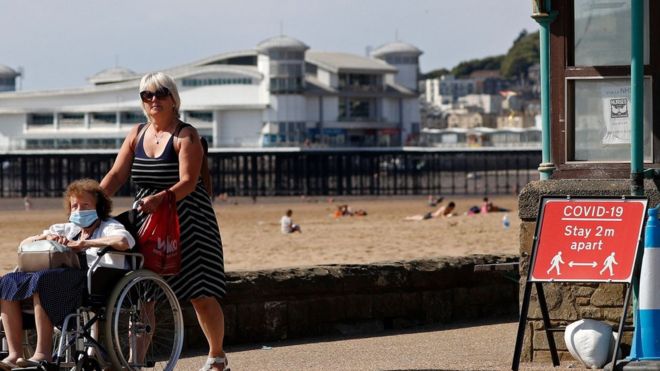
More than 31,000 close contacts were identified during the first week of the test and trace system in England, figures show.
Of those, 85% were reached in 24 hours and asked to self-isolate for 14 days.
This was from 8,000 people testing positive for coronavirus - two-thirds of whom provided details of their close contacts.
Around 25,000 contact tracers were recruited in England and started work at the end of May.
The NHS figures, which cover 28 May to 3 June, are the first to be released showing the progress of the contact tracing scheme.
'More to do'
Baroness Dido Harding, who runs NHS Test and Trace in England, said there was still "more to do to improve the speed" of the system but she said "the vast majority of people are participating and playing their part".
"I want to say thank you to people for protecting themselves and their communities," she added.
The system has been unable to reach 15% of close contacts, either because they were unavailable, their contact details were wrong or they did not respond to texts, emails or calls from contact tracers.
They are told to try calling 10 times in a 24-hour period.
Some who were reached did not agree to self-isolate.
But Baroness Harding said there had been "good numbers of compliance".
As lockdown eases, and people start to return to work and go out to shops, it's expected the number of contacts people have will start to grow from a low starting point.
Does this represent a good start?
The data from the test and trace system in England has been eagerly anticipated - after all, this system will be crucial in helping contain local outbreaks, enabling the country to ease out of lockdown.
It is still early days, but how should we interpret these findings?
Firstly, the system seems to be pretty good at reaching the contacts of people who have tested positive, if those positive cases engage with the contact tracers and provide details in the first place.
The problem is a third of people who test positive are not providing details.
This could be because the contact tracers are not as good as they should be at tracking those who do not engage with the online forms (the first point of call for the system).
There have been suggestions that sufficient translation support is not always available, for example.
But incorrect contact details being provided and people simply refusing to take calls - despite repeated attempts - are certainly factors too.
The key to the success of the system will be both an efficient service and public engagement in taking calls and following the advice to self-isolate.
What is test and trace?
It's a way of controlling the spread of the virus by asking people who have tested positive for coronavirus to share information on who they have been in close contact with.
It starts with getting a test if you have symptoms.
If you test positive for the virus, tracers will text, email or call you and ask you to log on to the NHS Test and Trace website to provide details of contacts.
Close contacts will then be told to stay at home for 14 days, even if they don't have symptoms.
This process is organised slightly differently around the UK.
What happens around the UK?
In Scotland, the system is called NHS Test and Protect, Between 28 May and 7 June 2020, 741 contacts were traced from 681 positive tests for the virus - an average of 1.5 contacts per case.
Northern Ireland was the first part of the UK to bring in contact tracing.
Contact tracing started in Wales on 1 June and is called 'test, trace, protect'.
Coronavirus: Ministers consider NHS contact-tracing app rethink
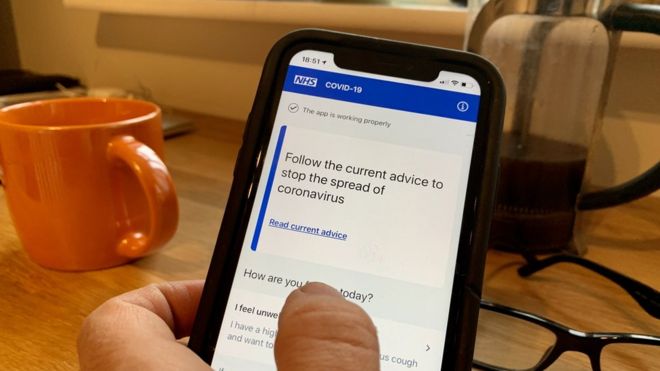
Concerns about the risks of deploying a go-it-alone UK coronavirus contact-tracing app are causing further delays.
A second version of the smartphone software was due to have begun testing on the Isle of Wight on Tuesday, but the government decided to postpone the trial.
Ministers are considering switching the app over to tech developed by Apple and Google.
But countries testing that model are experiencing issues of their own.
Health Secretary Matt Hancock had originally said the NHS Covid-19 app was to be launched across England - and possibly other parts of the UK - by 1 June.
But he subsequently said the government had decided it would be better to establish a network of human contract tracers first.
However, the BBC has discovered that one of the main reasons the initiative is running behind schedule is that developers are having problems using Bluetooth as a means to estimate distance.
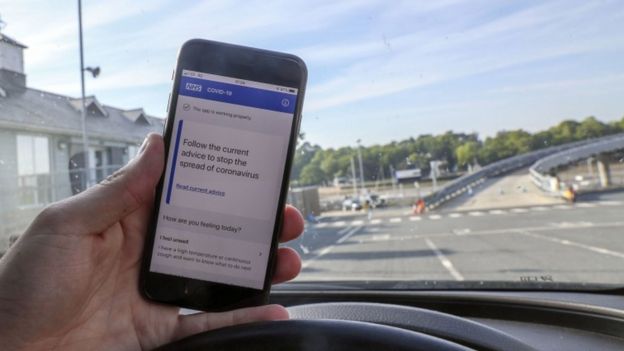
Even so, they still believe they are better placed to tackle the challenge than counterparts overseas who are working under constraints imposed by the two US tech firms.
Bluetooth handshakes
Contact-tracing apps are designed to prevent a second wave of infections by keeping a log of when two people are in close proximity to each other and for how long.
If one of the users later tests positive for the disease, the records are used to determine how likely it is they infected the other. If required, an alert is triggered to help prevent the further spread of the virus.
The UK has adopted what is known as a "centralised" approach, meaning that the contact-matching process is carried out on a remote computer server. One benefit is it offers epidemiologists more data to tackle the pandemic. France and India are other countries to have adopted this model.
By contrast, Apple and Google's "decentralised" approach carries out the matches on the handsets themselves, on the grounds this better protects users' privacy.
Poland switched its app from a centralised to decentralised approach on Tuesday. Switzerland, Ireland, Germany, Italy and Latvia are among others to have adopted the tech giants' design.

Both systems rely on Bluetooth "handshakes" to work.
Number 10 is concerned that iPhones will not always detect each other because of a restriction Apple has imposed on apps that do not adopt its model.
But the UK team has devised a workaround and is more concerned about other limitations of using Bluetooth.
Train trouble
Some of these issues were outlined in a study published by Trinity College Dublin last month.
It highlighted problems with using received Bluetooth signal strength as a means to estimate distance.
Researchers warned signal strength "can vary substantially" depending on:
- how deeply a handset is placed in a bag
- whether the signal has to pass through a human body to reach the other phone
- if the two people are walking side-by-side or one behind the other
- if the devices are indoors rather than outdoors
- whether the smartphone is surrounded by metal objects
The report highlighted troubling results when Singapore's TraceTogether app was tested.
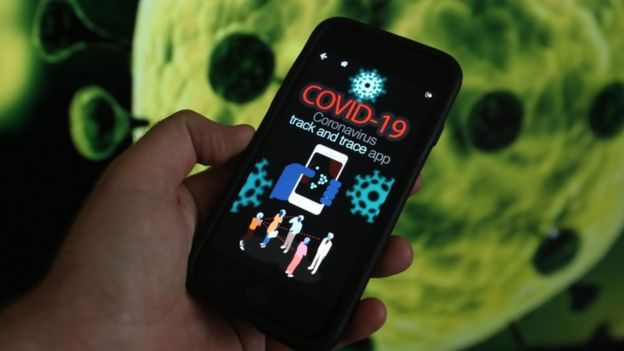
An experiment within a stationary train carriage found that when users moved from a distance of 3.5m (11.5ft) to 4m, signals became stronger rather than weaker because of the way metal objects were reflecting the radio waves.
A trial in a supermarket also found the received signal strength was the same whether two people were walking close together or 2m apart.
Follow-up tests using Apple-Google's tech are currently under way.
"The work is ongoing, but preliminary results are broadly consistent with previous observations," said Dr Brendan Jennings, who has been tasked with assessing the effectiveness of Ireland's Covid-19 app.
Hidden data
The team behind Switzerland's SwissCovid app is carrying out tests of its own.
Its Bluetooth measurement chief believes the issue can be partly addressed by taking a range of readings over a period of five minutes or more.
But he added that Apple and Google had placed curbs on what could be achieved.
"The Google and Apple API [application programming interface] limits the amount of raw information that is actually exposed to the app," Prof Mathias Payer told the BBC.
"For maximum utility, we would get all the different measurements, but this has privacy implications."
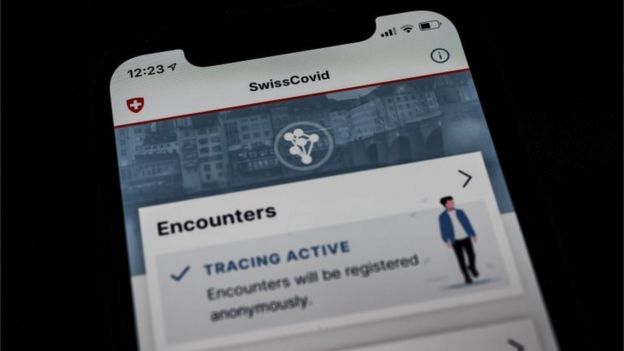
Apps using Google and Apple's tech do not get to see the actual signal strength but rather one of three values, based on calculations used to normalise the different ways Bluetooth behaves on different handsets,
By contrast, the UK team can currently obtain the measurements directly.
Those responsible believe a further advantage of their centralised approach is that the data can be processed on the server involved, since it would be too taxing a task to be done on smartphones.
But part of their challenge is communicating this to Baroness Dido Harding - who heads up the wider Test and Trace programme - and 10 Downing Street itself.
A spokesman for the prime minister declined to comment.
Coronavirus: Could social distancing of less than two metres work?

Prime Minister Boris Johnson has promised to keep the 2m (6ft) rule for social distancing "under constant review".
It comes after increasing pressure from MPs and the hospitality industry to cut it to 1m to help businesses after they reopen.
However, scientists continue to question whether that would be safe, given how little is known about how far coronavirus can spread.
What does the science say?
The simple answer is that the nearer you are to someone who is infected, the greater the risk of catching the virus.
The World Health Organization says that a distance of 1m is safe. Some countries have adopted this guidance, while others, including the UK, have gone further:
- 1m distancing rule - China, Denmark, France, Hong Kong, Lithuania, Singapore
- 1.4m - South Korea
- 1.5m - Australia, Belgium, Germany, Greece, Italy, Netherlands, Portugal
- 1.8m - US
- 2m - Canada, Spain, UK
It's not just about distance
Timing is also key. The longer you spend in close proximity with an infected person, the bigger the risk.
Scientists advising the UK government say that spending six seconds at a distance of 1m from someone is the same as spending one minute at a distance of 2m.
Being exposed to someone coughing is riskier. Being 2m away from a cough carries the same risk as someone talking to you for 30 minutes at the same distance.
What's the latest research?
In a study published in the medical journal The Lancet, scientists evaluated recent research into how coronavirus spreads.
They conclude that keeping at least 1m from other people could be the best way to limit the chances of infection.
The risk of being infected is estimated to be 13% within 1m, but only 3% beyond that distance.
And the study says that for every extra metre of distance up to 3m, the risk is further reduced by half.
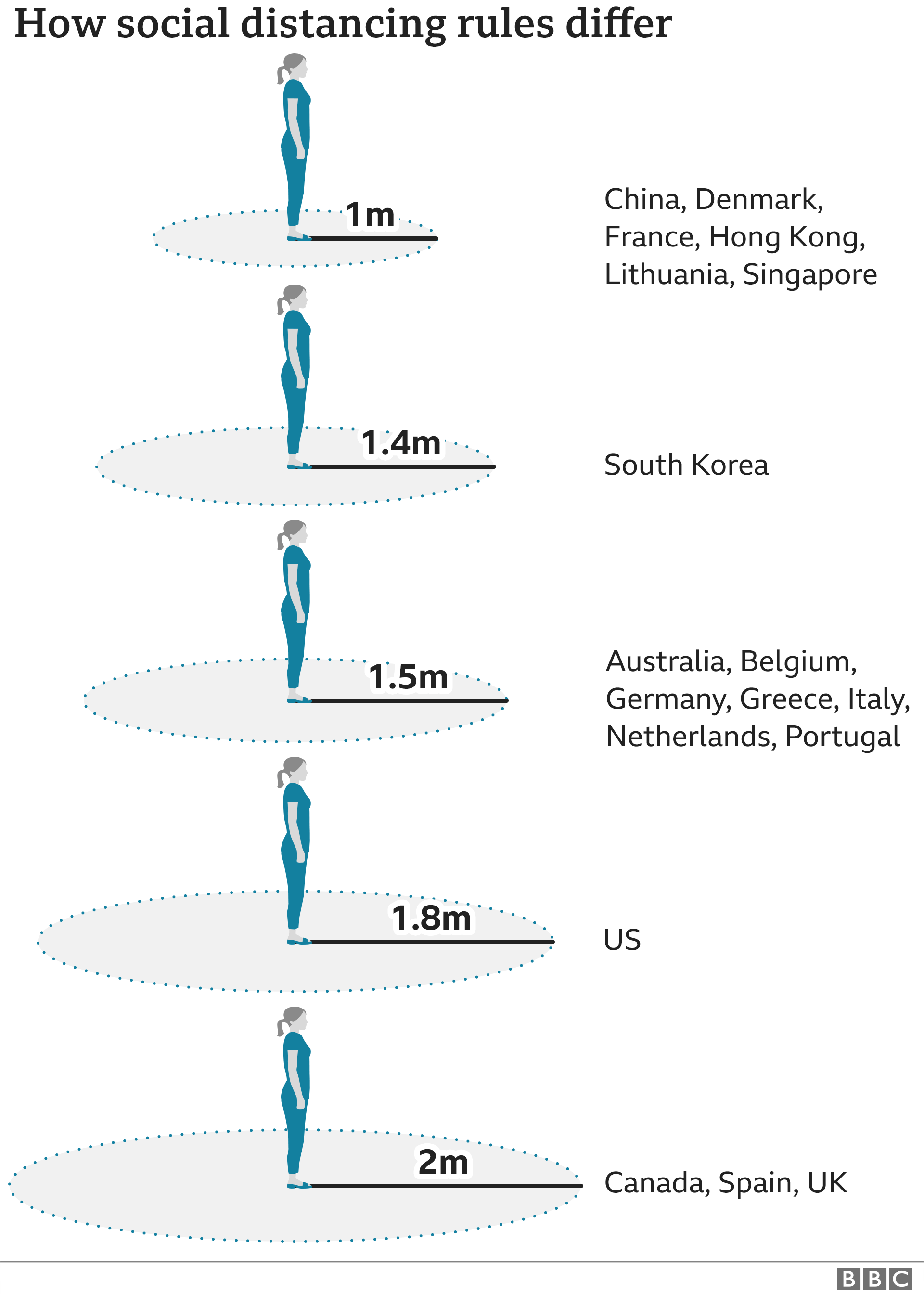
Where does the distancing rule come from?
It can be traced back to research in the 1930s.
Scientists found that droplets of liquid released by coughs or sneezes evaporate quickly in the air or fall to the ground.
Most of those droplets, they reckoned, would land within 1-2m.
That is why it is said the greatest risks come from having the virus coughed at you from close range, or from touching a surface that someone coughed onto, and then touching your face.
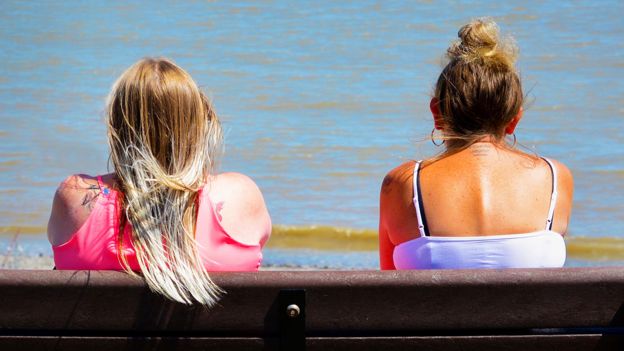
Can the virus travel further in other ways?
Proximity and surface contact are considered the main transmission routes.
But some researchers fear coronavirus can also be transported through the air in tiny particles called aerosols.
If true, then the flow of wind from someone's breath could carry the virus over longer distances.
Prof Lydia Bourouiba from the Massachusetts Institute of Technology (MIT) used high-speed cameras to capture a cough projecting miniature specks as far as 6m.
And a study carried out in Chinese hospitals which found traces of coronavirus in Covid-19 wards and intensive care units, estimated that 4m was a better safe distance.
But the US Centers for Disease Control says the role of aerosols in spreading the virus is "currently uncertain".
And what's still not known is whether any virus that spreads further than 2m can still be infectious.
- Coronavirus: Can we stay safe as lockdown eases?
What else makes a difference?
It is widely accepted that the infection is more easily passed on indoors than outside in the fresh air.
Japanese researchers investigated 110 cases of Covid-19, following up the contacts of those infected.
They estimated that the odds of the infection being passed on were nearly 19 times greater indoors than outside.
In many countries, including England and Scotland, people are being encouraged to wear face coverings on public transport and "enclosed spaces where social distancing is not always possible".
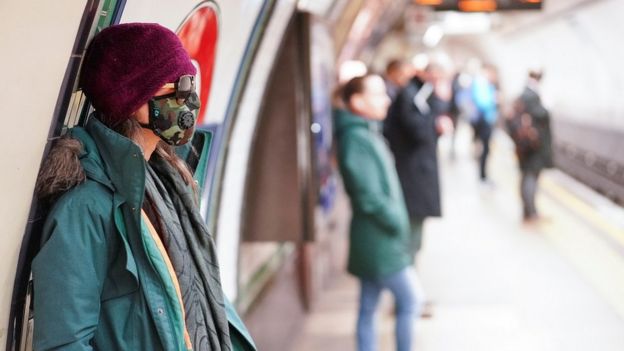
Why don't we have definite answers?
It is only a few months since the coronavirus emerged, and in that short time scientists have learned a great deal about it.
But there is a long way to go, and confirming exactly the right distance is one of the unanswered questions.
Answering it will require careful studies of how the virus can be carried, and how viable it remains, which will all take time.
China coronavirus outbreak: All the latest updates
The death toll in China from the deadly coronavirus outbreak that originated in the central city of Wuhan, rose to at least 361 on Monday, as the Philippines became the first country outside China to confirm a death from the infection.
The National Health Commission said there were 57 new fatalities on Sunday, all but one of them in Hubei, which has been effectively sealed off from the rest of the country for more than a week.
The total number of people infected with the virus rose to 17,205 across the country, after 2,829 new cases were reported.
Other countries have rushed to evacuate their citizens from Hubei province and its capital city, Wuhan, while many have also imposed extraordinary travel restrictions on travellers to and from China.
About 150 cases have been reported in two dozen other countries.
Here are the latest updates:
Monday, February 3
WHO combats virus misinformation
The World Health Organization said it was working around the clock with internet and social media giants to combat widespread misinformation surrounding the deadly novel coronavirus outbreak.
"We have worked with Google to make sure people searching for information about coronavirus see WHO information at the top of their search results," WHO chief Tedros Adhanom Ghebreyesus said in his opening remarks to the UN health agency's executive board meeting in Geneva.
"Social media platforms including Twitter, Facebook, Tencent and Tiktok have also taken steps to limit the spread of misinformation," he added.
6G TECHNOLOGY: JAPAN PLANS TO ACHIEVE 6G BY 2030
The Ministry of Internal Affairs and Communications of Japan will set up a government-civilian research society in January. Representatives from NTT Docomo and Toshiba will summarize comprehensive strategies such as 6G performance goals and policy support by June. Japan will promote the development of 6G technology using the government budget.
6g
2'
6GNEWS
6G TECHNOLOGY: JAPAN PLANS TO ACHIEVE 6G BY 2030
Efe UdinEFE UDINJANUARY 19, 2020
According to Nikkei, various countries have begun to target the next generation of communication technologies after 5G. Japan plans official-civilian cooperation to formulate a comprehensive strategy for “post-5G” (6G technology). It plans to achieve communication speeds that are 10 times faster than 5G by 2030. China, South Korea, and Finland have also started research, development, and investment. If you have patents related to communication standards, you can make huge profits through the sale of equipment and software. Japan, which is slowing down in 5G development, strives to catch up.
Join GizChina on Telegram
6G technology
The Ministry of Internal Affairs and Communications of Japan will set up a government-civilian research society in January. Representatives from NTT Docomo and Toshiba will summarize comprehensive strategies such as 6G performance goals and policy support by June. Japan will promote the development of 6G technology using the government budget.
Using “post-5G” (6G) high-speed communication technology, many unimaginable things will be possible. The speed of 6G must be at least 10 times faster than 5G. This is the plan of the Japanese Ministry of Internal Affairs and Communications. The research will center on network speeds that can instantly transfer large amounts of data instantly. This technology is suitable for transmitting large amounts of data. Unused high-frequency radio waves will also be used for communication.
OME PHONES REVIEWS WEARABLE TABLETS ABOUT US CONTACT US
6g
2'
6GNEWS
6G TECHNOLOGY: JAPAN PLANS TO ACHIEVE 6G BY 2030
Efe UdinEFE UDINJANUARY 19, 2020
According to Nikkei, various countries have begun to target the next generation of communication technologies after 5G. Japan plans official-civilian cooperation to formulate a comprehensive strategy for “post-5G” (6G technology). It plans to achieve communication speeds that are 10 times faster than 5G by 2030. China, South Korea, and Finland have also started research, development, and investment. If you have patents related to communication standards, you can make huge profits through the sale of equipment and software. Japan, which is slowing down in 5G development, strives to catch up.
Join GizChina on Telegram
6G technology
The Ministry of Internal Affairs and Communications of Japan will set up a government-civilian research society in January. Representatives from NTT Docomo and Toshiba will summarize comprehensive strategies such as 6G performance goals and policy support by June. Japan will promote the development of 6G technology using the government budget.
Using “post-5G” (6G) high-speed communication technology, many unimaginable things will be possible. The speed of 6G must be at least 10 times faster than 5G. This is the plan of the Japanese Ministry of Internal Affairs and Communications. The research will center on network speeds that can instantly transfer large amounts of data instantly. This technology is suitable for transmitting large amounts of data. Unused high-frequency radio waves will also be used for communication.
6G technology – research and development is on the way
In order to achieve 6G technology by 2030, countries have begun to take action. The Chinese government announced in November 2019 that it will establish two 6G R & D institutions. Finnish universities and government-affiliated institutions have also launched 6G R & D projects. In South Korea, Samsung Electronics and LG Electronics each set up research centers in 2019.
a top investment pick amid decoupling with the US, says CITIC Capital CEO
Health care is also an important sector as the Chinese society is aging rapidly, so there's robust demand for good health-care services, Zhang said.
Another potential area to invest in is technology services due to the potential decoupling with the U.S. in that area, Zhang said.
"For us, the top priority ... is still on consumption, because it's still growing at a higher rate than GDP growth," said Zhang Yichen, chairman and CEO at CITIC Capital, the flagship investment arm of Chinese state-owned conglomerate CITIC Group.
"Consolidation was needed to improve the return on capital, hence reducing the leverage through the improvement in cashflow, so buyout is clearly on the rise," he said.
Going forward, "most Chinese businesses need to improve themselves through expanding internationally," Zhang said.
However, "given the overall trade tensions, all the protectionism on the rise, we're clearly cautious on that front as well," he added.





